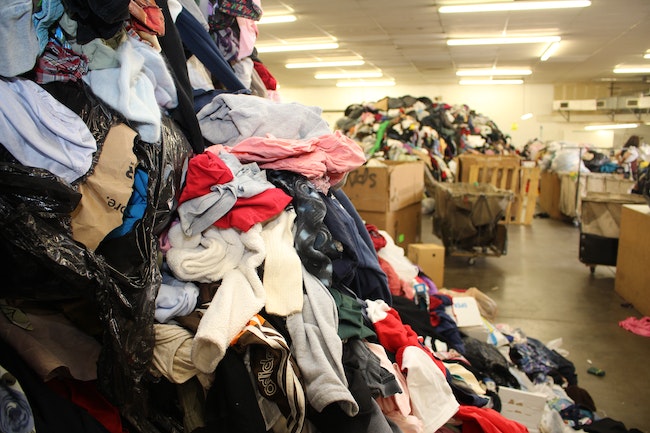 Clothes pile up at a St. Vincent de Paul warehouse in the southern Willamette Valley. Some clothes are from online returns.
Clothes pile up at a St. Vincent de Paul warehouse in the southern Willamette Valley. Some clothes are from online returns.
Full disclosure: I’m a tad ignorant when it comes to the business of retail. Having never worked in a typical department store or shop, I’ve lived my life blissfully unaware of what happens behind the scenes.
This lack of experience goes double for the process of returning items to an online retailer. As a Generation Xer, a lot of my formative shopping years happened when brick-and-mortar stores dominated the shopping experience. There in the confines of a fluorescent-lit dressing room, I would try on a coat or shirt to determine if it fit or looked presentable on me. I’d take a few possibilities behind the door or curtain, try them on, and then leave behind whatever I didn’t want. Or, if the garment was a holiday gift that didn’t fit, I’d simply return it to the store and the retail clerk would restock the item so another shopper could give it a go.
I always felt good that, even though I didn’t like the bomber jacket my aunt bought me for Christmas, at least someone else could buy it after I returned it to JCPenney.
Yet today, when around 60% of all clothing is purchased online, that return process is not nearly as simple and is certainly a whole lot more wasteful than I ever knew.
Unfortunately, I’ve bought into a myth that no longer exists in modern shopping: the stuff I return to an online retailer isn’t restocked and sent back out to another hopeful owner. Most online retailers simply can’t or won’t resell something that is returned in the mail no matter how perfect the item may be. And the reason has little to do with health concerns or quality control.
It’s all about the bottom line.
For most online retailers, it makes more sense to refund a customer’s money and throw the returned item away than to repackage the item to be sold to another customer. And if the returned items avoid the landfill, they are then resold in bulk to secondary retailers. While this is better than items being thrown away, it still creates a problem of over-manufactured and under-utilized resources.
Unlike me, Terry McDonald, executive director of the St. Vincent de Paul Society of Lane County, understands the strange and even ridiculous journey an article of clothing may take from first click to final destination. I thought it might be important to share my recent education with readers as we enter the final stretch of the holiday shopping and donation season. After all, according to shipping giant UPS, more items are returned after the holidays than at any other time.
“I think most people have no idea what happens to the stuff they return and probably don’t want to know,” McDonald told me when we recently spoke. “Unfortunately, a lot of perfectly good merchandise just gets chucked into a landfill. There are just too many hurdles in our global supply chain to simply repackage an item and resell it.”
A second path for returned items at least bypasses waste disposal and does allow for returned sweaters and coats to have a second life. Most enormous retailers like Amazon and Target can try to recoup some costs through two ways.
“Amazon will gather up massive quantities of returned items and sell them by the pallet,” McDonald said. “Then they are bought in total and resold. Whatever the initial buyer can’t resell domestically usually gets shipped in massive containers overseas. It’s how so many Nike, Ralph Lauren, and Levi’s merchandise ends up in cities and villages throughout Asia and Africa.”
McDonald said that while this might be better than throwing away the clothes, it still contributes to massive waste and massive use of fuel and resources to continually move returned items around the globe.
A big part of this problem is that consumers are coached to over-order. Whereas in the store, they can try on size after size and re-hang what doesn’t fit, online retail has created a system of “bracketing,” where a customer deliberately orders more than they need, such as multiple sizes or colors of the same garment. Once their order arrives, they can see how a medium fits vs. a large or extra-large, keeping one and returning the other two. But the two items shipped back are either thrown out or sent overseas.
This creates a situation in which way more clothing is manufactured than is needed. Our clothing industry is built to frontload much more than we can wear and saturates landfills and secondary markets. A major problem in this supply chain is the fact we can’t re-insert a perfectly good item into the primary market.
It’s like that animated movie “Cloudy With a Chance of Meatballs,” where the central character creates a machine that produces an unlimited supply of huge food. At first, it’s great, but then each day more and more car-sized pancakes – and yes, meatballs – rain down on a terrified populace, so much so that they can’t keep up with the crushing abundance of uneaten food.
According to management consultant McKinsey & Company, 60% of clothes purchased online are returned due to poor fit. All the more reason to curb the use of bracketing when shopping. It might be convenient to order three sweaters to find the one that fits perfectly, but it’s going to be better for the environment and the supply chain to simply buy one and then return a single item if it doesn’t fit.
This leads to the second fix: pay close attention to online reviews of products. They often tell you if a specific item runs big or small, or if the color is true to what’s displayed online.
You can visit a St. Vinnie’s thrift store or other second-hand outlet, too. “A Levi’s shirt is going to fit pretty uniformly, so try on one here and then, either buy it here or order a similar shirt online,” he said.
“So, if you receive a sweater from Aunt Betty this year that isn’t the right fit or the right color, returning it for another option is absolutely your right. If, however, you don’t need another sweater and you subscribe to the gift-giving philosophy that it’s the thought that counts, consider simply donating it to an operation like St. Vinnie’s. At the very least you are saving space in the landfill, and at most you are providing a great garment to someone who really wants, and perhaps, needs it.”
The holiday season is indeed a time of giving and receiving. Hopefully, we can stop it from being a season of wastefulness as well.
Email: [email protected]







